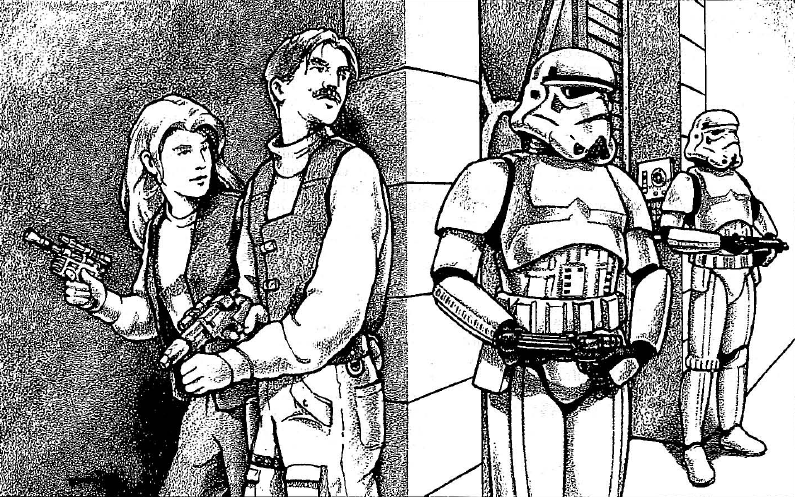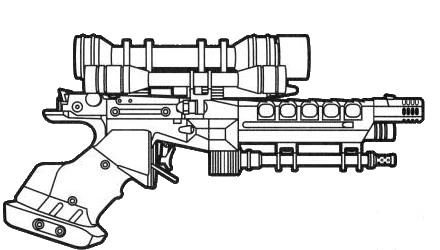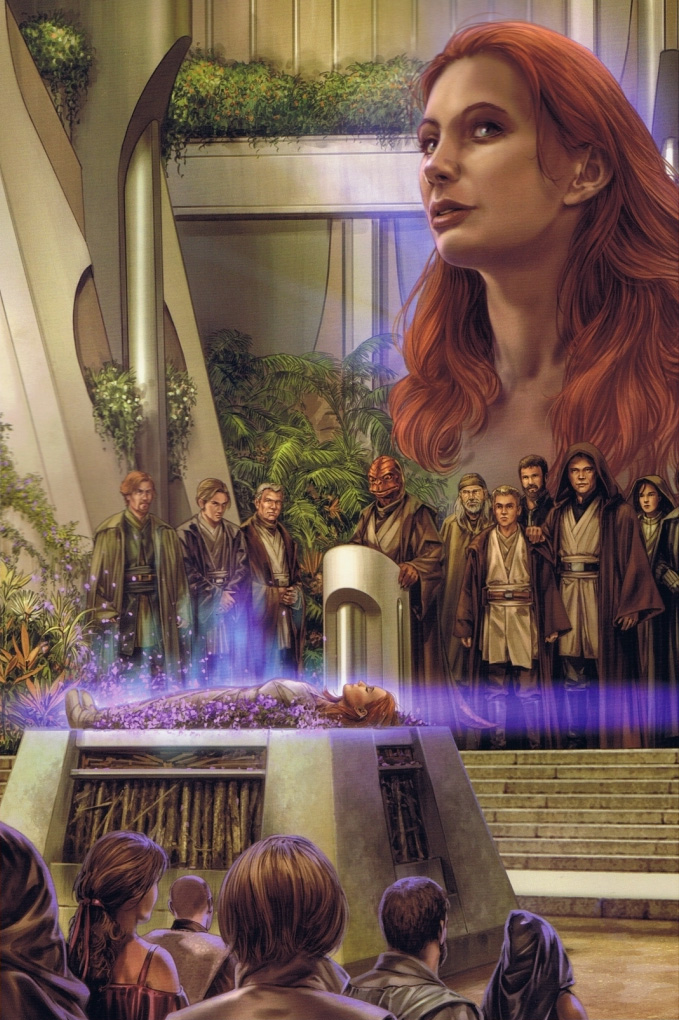Christopher J. Trevas has been an official Star Wars artist since 1995. He began as an illustrator for West End Games's Star Wars: The Roleplaying Game, producing artwork for publications such as Heroes & Rogues, the Shadows of the Empire Sourcebook, Instant Adventures, and the Star Wars Adventure Journal. He has contributed to numerous other projects, including Wizards of the Coast's Arms & Equipment Guide and their Star Wars Miniatures line, for which he designed many of the figures as well as the packaging art.
Some of Trevas's other works include Priority: X from Star Wars Galaxy Magazine 12, the "Guide to the Grand Army of the Republic," and A Two-Edged Sword, as well as two children's books: Meltdown on Hoth and Anakin to the Rescue. He was the author of the recurring feature in Star Wars Insider magazine titled "Set Piece," which ran from issue 54 to issue 100. More recently, Trevas co-illustrated The New Essential Guide to Alien Species with William O'Connor, Jedi vs. Sith: The Essential Guide to the Force with Tommy Lee Edwards, and Star Wars Blueprints: The Ultimate Collection. He has also illustrated the Legacy Era Campaign Guide by Wizards of the Coast and The Essential Atlas, where he cameos as a Human in a game of holochess.

An early Trevas drawing from Heroes & Rogues
In 1994, when Lucasfilm began recruiting artists for Episode I's art department, Trevas submitted a portfolio including various alien sketches, but he was not hired at that time. However, at a science-fiction convention in 1995 in Chicago, Illinois, he shared his portfolio with West End Games, who at the time held the Star Wars role-playing license, and was hired by them a few months later. Trevas produced interior artwork for numerous roleplaying game (RPG) books for them, including Heroes & Rogues, the Star Wars Adventure Journal, and supplements for The DarkStryder Campaign.
In 1996, Trevas graduated from college with a Bachelor of Fine Arts degree in Illustration. He then became a full-time freelance artist, continuing to create interior art for West End's Shadows of the Empire Sourcebook, Shadows of the Empire Planets Guide, Instant Adventures, Star Wars Trilogy Sourcebook, Special Edition, as well as cover art for Wretched Hives of Scum & Villainy, The Black Sands of Socorro and Cracken's Threat Dossier. In 1997, the year before West End Games' collapse, Trevas began doing work for other Star Wars licensees, including Priority: X for Topps' Star Wars Galaxy magazine and became a regular artist for Scholastic's Star Wars Kids magazine. He continued to branch out to other companies, illustrating Meltdown on Hoth for Golden Books and "The Unseen Planets of Star Wars" for Star Wars Insider.
In 1998, Chris Trevas and Chris Reiff created an unofficial fan site called "The Parts of Star Wars," a guide explaining how many of the props in the Star Wars films were made and how they could be recreated. The next year, he illustrated Dig magazine's The Lost City of Tatooine and the Random House children's book Anakin to the Rescue. In 2001, Star Wars Insider called upon the expertise of Trevas and Reiff for a new section called "Set Piece," a recurring feature—beginning in issue 54—which takes a shot from one of the films and points out behind-the-scenes facts about props and sets; it also features line art by Trevas of selected props. He also illustrated "Unseen Planets of Episode I" in issue 56, a follow-up to the 1998 classic trilogy article.

The S-5 heavy blaster pistol from the Arms & Equipment Guide, an example of Trevas's line art
For Star Wars 25th anniversary in 2002, Trevas wrote and illustrated "Star Wars Prop Art: Creating a Believable Universe" for the Celebration II souvenir book and created Star Wars art for Comic-Con's souvenir book. The same year, he began working for Wizards of the Coast, illustrating numerous weapons and technologies for their Arms & Equipment Guide. In 2003, he created the Jedi Temple computer screens that would appear in Inside the Worlds of Star Wars: Attack of the Clones, published by Dorling Kindersley. In the following years, he would do more work for Wizards of the Coast: illustrations for Ultimate Adversaries and the Ultimate Missions series, for the latter of which he would design the accompanying figurines. Trevas was also one of the many artists who began drawing sketch cards for Topps, after a recommendation by his friend and fellow artist Joe Corroney.
In addition to his regular "Set Piece" feature, Trevas illustrated three articles for Insider in 2005: "The Unseen Planets of Episode II," "Guide to the Grand Army of the Republic," and the short story A Two-Edged Sword. For the story, which featured lightsaber-wielding stormtroopers, Trevas created a physical lightsaber prop to use as reference. He also created a work for Vader: The Ultimate Guide which shows Darth Vader ordering the execution of Owen and Beru Lars. For Celebration III that year, he created a piece called "The Circle is Now Complete." Trevas continued to contribute to the Wizards of the Coast RPG with either artwork or design sketches for their Champions of the Force, Bounty Hunters, and Starship Battles Miniatures series.

Trevas's commissioned print for Celebration VI
In 2006, Trevas received from Del Rey his biggest Star Wars project yet: The New Essential Guide to Alien Species. Trevas created fifty-three species images—half of the images in the book; the other half were done by William O'Connor. Trevas's illustrations included the acklay, bantha, dewback, Human (based on his own likeness), Kaleesh, rancor, Rodian, tauntaun, Twi'lek, and many others. Several of his aliens in the book were intended to be as-of-yet unnamed characters from his previous works. For the 30th anniversary of Star Wars in 2007, Trevas was one of almost fifty artists to create a work for Celebration IV. His piece, titled "Star Wars: 30 Years of the Force," celebrated A New Hope and was obviously inspired by an early promotional piece by Ralph McQuarrie. Prints of the work were sold in limited numbers at Celebration IV and Celebration Europe, both of which Trevas attended.
Trevas's most recent work is Jedi vs. Sith: The Essential Guide to the Force. The book, written by Ryder Windham, is illustrated by Trevas and Tommy Lee Edwards. The two evenly split the workload of 120 illustrations. Trevas, who came onto the project in January 2007, created sixty pieces for the book, with pieces including the funeral of Mara Jade Skywalker, the Jedi Academy confronting the spirit of Exar Kun, Shmi and Anakin Skywalker arriving on Tatooine, Jedi historian Tionne Solusar, a young Palpatine with Darth Plagueis, and many others. One of his favorite pieces was of Obi-Wan Kenobi's Force ghost visiting Luke Skywalker on Hoth. Trevas again collaborated with Ryder Windham for Star Wars Blueprints: The Ultimate Collection, which was released in August 2008. In 2009, Trevas worked as one of the artists on The Essential Atlas, alongside Ian Fullwood, Modi, and Chris Reiff.
Trevas worked on the book From a Certain Point of View, providing illustrations for all of the short stories within, save for the story "Far Too Remote" by Jeffrey Brown.

The funeral of Mara Jade Skywalker, an example of Trevas's detailed, full-color rendering style and attention to visual continuity for Expanded Universe characters
Both as a child and in his professional career, Trevas cites Star Wars conceptual artist Ralph McQuarrie as one of his major influences. McQuarrie's work inspired him to concentrate on illustrating environments, not just characters. Another important influence, particularly because of his mixing of pencil and paint, was poster artist Drew Struzan. More recently, Trevas has looked to the work of digital artists such as Ryan Church and Craig Mullens.
The illustrative style of Chris Trevas has evolved over the years. While he used colored pencils during high school, he began to mix them with paint and eventually moved to using acrylic exclusively. Years later, Trevas switched to painting digitally in Adobe Photoshop via a Wacom drawing tablet. He also uses Adobe Illustrator for line art drawings.